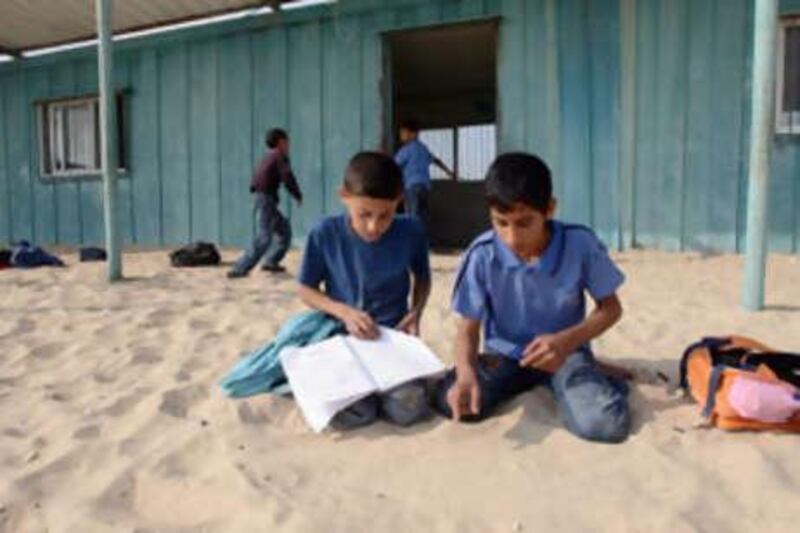RAFAH, GAZA STRIP // When it rains in Gaza - the cold, heavy downpours that are common this time of year - Wafa Shalouf, 15, all but abandons any attempt at studying. The rain thunders on the iron roof of her makeshift school, drowning out the voice of her teacher, and leaks in through the holes in the roof, soaking her textbooks. "My clothes, books and school bag get drenched when it rains. There is nowhere to go to stay dry. Even inside the classroom, I am still cold and can't escape the downpour," she said.
Wafa is one of nearly 450 pupils who attend the school in Al Mawasi, a district overlooking the Egyptian-Gaza border and close to Gaza's coast. Up until Israel pulled out of Gaza in 2005, the district had been cut off from the rest of the strip and the school - made up of metal cabins - was set up as a temporary alternative. "We set up these caravans for schoolchildren living in a closed-in area where it was hard to reach other schools," said Dr Said Harb, the director of the ministry of education and higher education's Rafah branch.
Three years after Israel pulled out of the coastal strip, the school is still being used as many teachers and pupils cannot afford to travel to other areas. "My father is a farmer who doesn't have enough income to send us to a school outside of Al Mawasi," said Wafa, who is one of seven children. Farid Saidam, the school's headmaster, said some of the students would walk two to three kilometres to reach the school, and some teachers must hike up to an hour to get to work.
Wafa considers herself lucky to live nearby. There are plans to renovate the school, to replace the iron and steel shacks with a proper cement structure. According to Mr Saidam, a German donor has offered the necessary funding, but with the Israeli blockade of the Gaza strip, there is nothing to build the school with. "The obstacle, due to the siege on Gaza, is actually getting the building materials into the Gaza Strip," said Dr Harb, who confirmed that plans to build a concrete school for the students dated back to 2005.
"It pains me when I realise that we are entering the 21st century, where people have reached the Moon, but we aren't able to make a safe and proper teaching environment." The siege was first imposed on Gaza's 1.5 million Palestinians after Hamas won a parliamentary election in Jan 2006. Despite calls from the United Nations and other international organisations to ease restrictions on the movement of people and goods, the situation has become ever more dire, especially after Hamas seized control of the strip last year.
Israel has started to allow basic food supplies into the area since an Egypt-mediated peace deal, yet international and Palestinian authorities describe the amount as inadequate for Gaza's population, 80 per cent of whom are dependent on food aid. Palestinian sources estimate that tens of thousands of workers in Gaza have been laid off as a result of the Israeli siege. Due to the lack of materials, hundreds of workshops and factories have had to shut down.
"Israel has to lift the siege and allow raw materials and building supplies into Gaza," Mr Saidam said. While teachers and pupils place the blame foremost on the Israeli occupation, they say the internecine fighting between Palestinian factions has also been a factor. "European countries should put more pressure on Israel to reopen the borders and lift the siege on Gaza,"said Omar Shaban, a Gaza-based economist.
"This is a collective punishment. There is no reason to condemn Gaza's children to flooded, leaky classrooms because Palestinians voted for Hamas." The school's troubles extend beyond winter rain and cold weather. In the summer, said Wafa, "we are basically in steel cans, we melt inside and have no fresh air. Even the classroom door and windows don't function properly - they cannot close, as they are warped with age and weather."
Nahed Issa, the mathematics teacher, has her own problems with the school. "The chalk melts from the rain which leaks through, rendering it useless for writing, for teaching. "The bathrooms are a disaster. They are unsanitary. Chicken farms are more hygienic." The United Nations, when asked what it was doing about improving conditions at the school, would not comment except to say it was aware that the caravan school had to be closed for a day due to flooding.
Yet, despite the conditions, some students do very well. "We still have excellent students who finish with very good grades," said Ms Issa. The caravan school has 24 teachers, with about 450 students, and a section each for boys and for girls, separated by barbed wire. One caravan holds about 15 students, but in some cases they must squeeze 22 in. "Where are my rights as a teacher to have real classrooms and not simply some inadequate and overcrowded caravan?" said Ms Issa.
"Some of my colleagues must even sit outside the caravans when it's too crowded. "Even the playground is like the desert. One student fell into a sewage well while she was playing, but thankfully we were able to rescue her." The safety hazards extend to the stability of the structures themselves. Some students fear that one day these metal roofs will fall on their heads. "The more I hear heavy rain pounding," said Wafa, "the more I realise that the roof could fall any moment."
* The National





